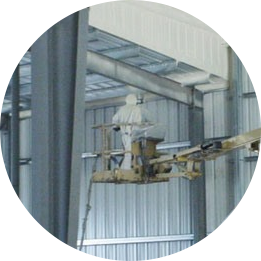
Spray polyurethane foam insulation is ideal for commercial applications as it is energy efficient, improves your air quality and offers sound reduction. As an insulation and air barrier system, spray polyurethane foam insulation provides optimal airtightness, which greatly reduces your energy bills. Your business could see up to a 60% savings! The initial cost of spray polyurethane foam insulation is greater than that of a traditional insulation, but if you consider the multiple benefits and lower life cycle costs, you will see that insulating with spray foam insulation is one of the most cost effective solutions today!
Benefits of Spray Polyurethane Foam Insulation:
- Improved air quality
- Sound Reduction
- Energy Efficiency
- Moisture resistant/mold elimination
Frequently Asked Questions (FAQ)
How long does it take to cure?
Spray foam expands up to 100 times its original volume within 4-10 seconds. Independent studies indicate that with 24 hours' active ventilation after spraying is completed, spray foam insulation is safely cured.
Can spray foam change physically over time?
No. spray foam products are chemically inert, meaning they will not change chemically or physically over time.
Does the Foam entrap moisture?
Open-cell spray foam insulation products are vapor permeable to allow water vapor molecules to flow through the foam. This means any moisture in the building's concrete or lumber can escape through the insulation as the building dries out, thus eliminating moisture that could cause rot or mold.
Closed-cell spray foam insulation products are able to reject bulk water and block mass transfer of moisture that may cause mold.
How environmentally sound is spray foam?
Spray foams are considered to be an environmentally preferred products due to their air sealing qualities which contribute to improved indoor air quality, reductions in energy consumption as well as greenhouse gas emissions. Spray foam is listed in the industry-recognized GreenSpec® Directory and the Green Wizard directory. GreenSpec® products are selected based on independent research which ensures unbiased, quality information.
Are there any harmful emissions?
Spray foams are safe for both you and the environment. Most spray foam products are water-blown, and do not emit HFCs or HCFCs. Extensive testing in North America have shown that no VOCs are detected after 30 days following installation. Manufacturers recommend that once sprayed, spray foam should be allowed 24 hours with adequate ventilation to fully cure.
Spray foam is ideal for use in homes for many environmentally concerned people.
How long has spray foam been available and in use?
Spray foam insulation has available since 1986. It has been used in millions of buildings. It is available in over 30 countries on four continents worldwide. It has been featured numerous times on television programs such as “This Old House” and “Your New House”.
Does spray foam support bacterial and/or fungal growth?
Spray foam insulation products do not offer any food value, therefore do not support bacterial or fungal growth. Furthermore, it also does not retain water, making it an unappealing environment for fungal spores. University of Texas has done an experiment on mold growth ability on three different insulation types (spray foam, fiberglass with foil face and fiberglass with vapor barrier). Spray foam was found to be the best deterrent for mold growth among the types tested.